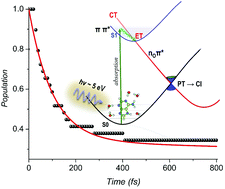Adenine ultrafast photorelaxation via electron-driven proton transfer†
Abstract
Photorelaxation of adenine in water was reported to be ultrafast (within 180 fs) primarily due to radiationless relaxation. However, in the last two decades, several experimental and theoretical investigations on photoexcitation of adenine have revealed diverse types of decay mechanisms. Using time-dependent density functional excited-state nonadiabatic dynamics simulations we show that it is the water to adenine electron-driven proton transfer (EDPT) barrierless reaction responsible for the ultrafast component of the adenine relaxation, which, however, occurred only in the case of the 7H isomer of adenine with five water molecules. This result reveals a known reaction pathway, however not found in previous simulations, with inference for the ultrafast relaxation mechanisms of adenine reported in experiments. The 9H isomer of adenine with six water molecules relaxing in a water cluster followed the previously known structural distortion (C2) decay pathway. The observations of the adenine EDPT reaction with water provide the origin of the experimental ultrafast adenine decay component and present a possible method to tackle future computational challenges in molecular-level biological processes.



 Please wait while we load your content...
Please wait while we load your content...